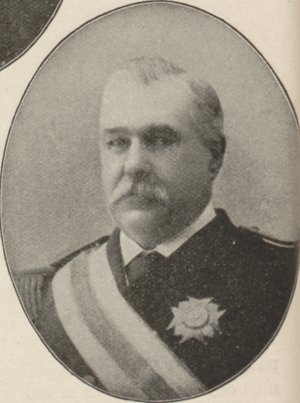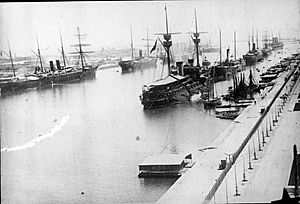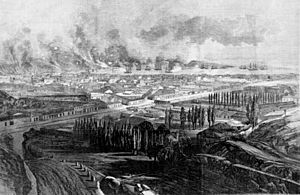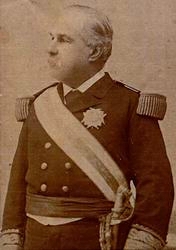Manuel de la Cámara facts for kids
Quick facts for kids
Manuel de la Cámara
|
|
|---|---|
 |
|
| Born | 7 May 1836 Málaga, Province of Málaga, Spain |
| Died | 4 January 1920 (aged 83) Málaga, Province of Málaga, Spain |
| Buried |
Cemetery of San Miguel, Málaga, Province of Málaga, Spain
|
| Allegiance | |
| Service/ |
|
| Years of service | 1852–1903 |
| Rank | |
| Commands held |
|
| Battles/wars | |
| Awards |
|
Manuel de la Cámara y Livermoore (May 7, 1836 – January 4, 1920) was an important Spanish naval officer. He served in many of Spain's wars in the late 1800s. He is most famous for leading a group of ships that tried to help Spanish forces in the Philippine Islands during the Spanish–American War.
Contents
Early Life and Family Background
Manuel de la Cámara was born in Málaga, Spain, on May 7, 1836. His family were merchants. His father, José de la Cámara y Moreno, was a Spanish merchant sailor and ship captain. His mother, Dolores Livermore Salas, was English. Because his mother was English, Manuel learned to speak English when he was a child.
After finishing school in Málaga, he joined the Spanish naval academy in San Fernando in July 1850. He finished his studies there in 1852.
In 1856, a sad event happened in his family. Manuel's sister, Matilde, was on a Spanish steamship called Miño. The ship sank in the Strait of Gibraltar after hitting another ship. Matilde was one of 94 people who drowned.
After graduating from the naval academy, Cámara joined the Spanish Navy in 1852. He started as a midshipman, which is a junior officer rank. He sailed on a training ship with other midshipmen. Then, he became an officer with the rank of alférez de fragata, like a junior ensign.
From 1852 to 1858, he served in the waters around Spain and the Antilles. In 1858, he was promoted to alférez de navío, a higher ensign rank. He was then sent to Havana, Cuba. He served on several ships and took part in the Hispano-Moroccan War (1859–1860). His commanders noticed his excellent skills as an officer.
In 1861, Spain, France, and the United Kingdom agreed to block Mexico's ports. This was to make Mexico pay back its loans. Cámara went to Mexico in 1862 to help with this blockade. He worked with the staff of a French Vice Admiral. He returned to Spain in 1863.
Chincha Islands War Service
In 1864, Cámara became the sailing master on the ship Vencedora. This ship was part of the Pacific Squadron. The Chincha Islands War started that year between Spain and Peru. Later, Bolivia, Chile, and Ecuador joined Peru.
Cámara moved to a more modern ship, the frigate Villa de Madrid. He was her sailing master and navigator. In 1865, he was promoted to teniente de navío (ship-of-the-line lieutenant). He fought in many important battles of the war.
In 1866, Villa de Madrid helped blockade Chile's ports. She also fought in the Battle of Abtao on February 7, 1866. In this battle, Villa de Madrid and another Spanish frigate showed good aim against Peruvian and Chilean ships. Villa de Madrid also took part in the bombardment of Valparaíso, Chile, on March 31, 1866.
Cámara also fought in the main naval battle of the war, the Battle of Callao, on May 2, 1866. Spanish ships attacked the forts at Callao, Peru. During the battle, Villa de Madrid was hit and damaged. Cámara was in charge of a battery of guns on the ship. He played a brave role, firing his guns until they ran out of ammunition. For his actions, Cámara received the Cross of Naval Merit First Class. He was also made commander of the Spanish Marine Corps.
After the war ended in 1866, Cámara was promoted quickly. In 1867, he worked for the Spanish Navy in London, United Kingdom. He then served on the armored frigates Vitoria and Arapiles. In 1868, he was promoted again. He then commanded the gunboat Prueba in the Philippines. His ship helped survey the waters there. In 1870, he returned to Spain.
Ten Years' War and Other Duties
In 1872, Cámara was sent to Havana, Cuba. The Ten Years' War had started there in 1868. In Cuba, he commanded the gunboat Cuba Española. He patrolled the coast and helped defend Guantánamo against Cuban rebels. For this, he received the Cross of Military Merit and another Cross of Naval Merit. He also commanded other ships during the war.
In 1873, a crisis happened with the United States. A Spanish ship captured an American ship called Virginius, which was helping Cuban rebels. Many people on board were executed. This almost led to war. Spain agreed to return Virginius to the United States. Cámara helped arrange this return peacefully.
In 1876, Cámara was promoted to capitán de fragata (frigate captain). He commanded the corvette Africa. Later, he commanded the ship Tornado. Under his command, Tornado sailed between Spain and Morocco, carrying important officials.
In 1885, Cámara became the head of the Spanish Navy office in Washington, D.C., United States. He was a naval attaché at the Spanish embassy. He held this job until 1888. He then returned to Spain and was promoted to capitán de navío (ship-of-the-line captain). He then commanded the cruisers Reina Mercedes and Castilla.
The 1890s and the "Black Squadron"
In 1890, Cámara took command of the Philippine Division. This was a group of ships meant to strengthen the Spanish Navy in the Philippines. The division sailed from Spain in April 1890. They traveled through the Mediterranean Sea, the Suez Canal, and the Indian Ocean. They arrived in Manila, Philippines, in June 1890.
In the Philippines, this group of ships became known as the "Black Squadron." This was because their ships were painted black, unlike other ships in the area that were white. Cámara commanded this division until December 1890, when he became ill.
Cámara returned to Spain in 1891. After recovering, he was put in charge of the Maritime Department of Havana in Cuba. He also commanded the Antilles Squadron. In 1892, he returned to Spain and commanded the cruiser Navarra.
In 1893, he became the port captain in his hometown of Málaga. He hoped for more rest there. However, the First Rif War broke out in Morocco. Many Spanish Army troops needed to be sent to Morocco. The navy did not have enough ships. Cámara was ordered to organize their transportation. He did a great job finding and hiring ships. He received many compliments for his work during the war.
In April 1894, Cámara was promoted to capitán de navío de 1.ª clase (ship-of-the-line captain first class). In 1895, he returned to London as the naval attaché at the Spanish embassy. In April 1897, he was promoted to rear admiral. He then became commander of the Reserve Squadron in Spain. He also represented the Spanish Navy at Queen Victoria's Diamond Jubilee in the United Kingdom in June 1897.
Spanish–American War Role
Shortly after the Spanish–American War began in April 1898, the Spanish Navy gathered its main ships at Cádiz. These ships formed the 2nd Squadron, commanded by Cámara. Two of Spain's most powerful warships, the battleship Pelayo and the armored cruiser Emperador Carlos V, joined his squadron. One of the squadron's jobs was to protect the Spanish coast from U.S. Navy attacks.
In May 1898, the U.S. Navy destroyed the Spanish squadron in the Philippines. Spain then considered sending Cámara's squadron to the Philippines. The U.S. was worried because Cámara's ships were very powerful. The U.S. quickly sent more troops and ships to the Philippines.

On June 15, 1898, Cámara finally received his orders. He was to sail immediately to the Philippines. He would escort a convoy carrying 4,000 Spanish Army troops. His main mission was to destroy the U.S. squadron there.
Cámara left Cádiz on June 16, 1898. His squadron included his flagship Pelayo, Emperador Carlos V, other cruisers, destroyers, and troop transports. They sailed through the Mediterranean Sea and arrived at Port Said, Egypt, on June 26.
In Egypt, Cámara tried to get more coal for his ships. However, the United States had already bought all the available coal. Also, the British government, which controlled Egypt, told him he could not get coal there. They said his ships had enough coal to return to Spain and that coaling would break neutrality rules. Cámara had to leave within 24 hours.
Cámara's squadron sailed through the Suez Canal on July 5–6, 1898. By this time, the main Spanish squadron in the Caribbean had been destroyed in the Battle of Santiago de Cuba. The Spanish government, worried about its own coast, ordered Cámara's squadron to return. On July 7, 1898, Cámara's ships, which had reached the Red Sea, turned back. They arrived in Spain on July 23. The 2nd Squadron was then disbanded on July 25, 1898.
The Spanish–American War ended on August 12, 1898. Spain lost the war. Cámara and his ships did not get a chance to fight in any battles.
Later Career and Retirement
After returning from his journey and the squadron was disbanded, Cámara went back to commanding the Reserve Squadron. In 1899, it was renamed the Instructional Squadron. As its commander, he was in charge of training ships for naval cadets. They sailed around Spain and to the Canary Islands.
In 1901, he became the captain general of the Department of Ferrol. In 1902, he became an aide to King Alfonso XIII. He met King Carlos I of Portugal at the border and escorted him to Madrid. In May 1903, he was promoted to vice admiral. He was also made president of the Merchant Marine Board.
During his career, Cámara also served twice as the Director of Materiel at the Spanish Ministry of the Navy.
In August 1903, Cámara asked to be transferred to the reserve list and retired from the navy. In 1912, the Spanish Navy changed its rank system. Because of this, Cámara's rank became full admiral even though he was retired.
Honors and Awards Received
Manuel de la Cámara received many awards, including:
 Cross of Naval Merit First Class (twice)
Cross of Naval Merit First Class (twice) Cross of Military Merit
Cross of Military Merit Grand Cross of the Order of Charles III (1901)
Grand Cross of the Order of Charles III (1901) Royal and Military Order of Saint Hermenegild (1902)
Royal and Military Order of Saint Hermenegild (1902) Grand Cross of the Order of Naval Merit with white insignia (1903)
Grand Cross of the Order of Naval Merit with white insignia (1903) Grand Cross of the Royal and Military Order of Saint Hermenegild (1911)
Grand Cross of the Royal and Military Order of Saint Hermenegild (1911) Honorary assistant of the Military House of S.M. King D. Alfonso XIII
Honorary assistant of the Military House of S.M. King D. Alfonso XIII
Personal Life
Cámara married Emma Díaz Gayen in Málaga on August 1, 1878. They had three sons and one daughter.
Manuel de la Cámara was a modest and quiet person. He was determined and strong-willed in his work. But he was also kind and generous to his friends. He was a wealthy man and lived a comfortable life, but he was not flashy. He was also very religious and often taught sailors about faith. He was loyal to the Spanish royal family. He often spent time quietly in London during his navy leaves because he liked the United Kingdom.
Death
Manuel de la Cámara died in Málaga on January 4, 1920. He is buried in the Cemetery of San Miguel in Málaga.
See also
 In Spanish: Manuel de la Cámara y Livermore para niños
In Spanish: Manuel de la Cámara y Livermore para niños





